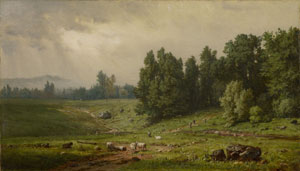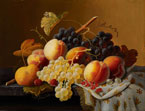Landscape, Still Life, and Genre
While the eighteenth century witnessed an America with one foot in European culture, the nineteenth brought about a period of self-discovery and coming-of-age for the young nation. Cultural optimism and the expectation of greatness dominated the imagery of the age. Sumptuous still lifes with allusions to abundance, and anecdotal genre scenes celebrating the simple joys and values of the common folk, were the idealized visual documents of democratic America. But in considering the century's artistic output, it is the enduring landscape tradition that clarifies the close link between love of land and the formation of the American identity.
America's vast expanse of available land was a beacon of adventure and opportunity to all who were willing to brave the dangers of the wilderness and undertake the hard work required to settle it. The nation's natural resources and picturesque wonders—from Niagara Falls to the Rocky Mountains—seemed uniquely American in scope and visual splendor. Artists, particularly those of the Hudson River School, gave visual expression to the nationalistic belief that any country so abundantly blessed was divinely ordained for greatness.
Roughly spanning the years from 1820 to 1870, the Hudson River School dominated artistic production in the United States. Although considered the first truly American school of art, its stylistic roots were connected to European aesthetic theories of the romantic sublime and the picturesque landscape. Such works relied on dynamic compositional formulas, detailed realism, and bravura manipulation of atmospheric light effects to induce a sense of awe in the beholder.
The carnage of the Civil War squelched the optimism and the patriotic fervor that had inspired such idealized landscapes. Suddenly, these works seemed naïve and even untruthful. It was only with the passage of time that they were reevaluated in terms of technical mastery and treasured as the expression of a formative era in America's identity.







